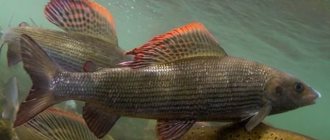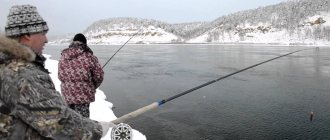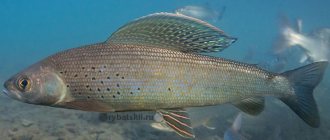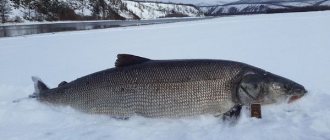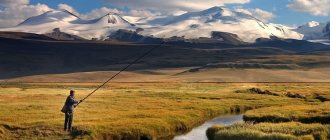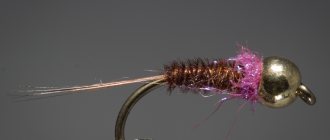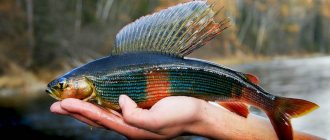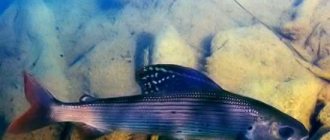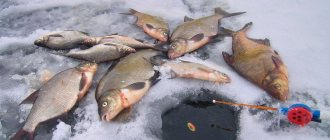The process of catching grayling in winter for a European fisherman is somewhat different from the usual fishing for roach or crucian carp. For Siberians and northerners, this is a common seasonal phenomenon, especially on the first and last ice - in some places this beauty is caught systematically and in large quantities in winter. Special habitats and habits form specific tactics and nuances of fishing.
Ice fishing for grayling is a separate event. According to the principle, I abandoned it - what if it takes something and you won’t catch it. This requires a special approach, tactics and equipment. Let's take a closer look at how and where to catch grayling in winter, what gear and tactics to use.
Where to look for grayling in winter
Grayling is known to fishermen as an active and cautious predator, but in winter it becomes sluggish, and with the proper knowledge it is much easier to catch it. This fish lives only in clean reservoirs, without stagnant water, on a sandy or rocky bottom. The usual habitat is northern rivers, including the smallest ones.
In winter, grayling usually stays at slightly greater depths than in summer, between riffles, guarding its prey in relatively calm water near the stream. However, this is not a rule. In some reservoirs, during certain periods of winter, it also stands on the shallows.
In our country, grayling exists in two ecological forms. Brook grayling is smaller in size; it usually lives sedentary in a particular stream or river, without making long seasonal migrations. The river fish is larger; in winter it makes mass migrations due to changes in environmental conditions.
In winter, the river fish hides in holes, and in rivers where there is a lot of slush under the ice, it usually slides down to the mouth zone, closer to larger bodies of water. A lot of this fish lives permanently in large Siberian rivers, such as the Yenisei, Lena or Ob. This division is valid for any type of grayling, both Siberian and European.
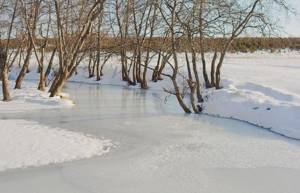
Habitats in winter
If the river does not freeze to the bottom in winter and is not sanded with slush, then the grayling may not go anywhere at all, simply moving not far from deeper places to shallow ones and back again. It can also spend the winter in artificial reservoirs and beaver backwaters.
- On large and medium-sized rivers, grayling moves from rapids and rifts to calm and deeper reaches with a stone or pebble bottom for the winter.
- In Siberia, they focus more on seasonal mass winter fishing of grayling during certain periods, when it is caught in places accessible from the city, in larger reservoirs, at the mouths or on the large rivers themselves.
- However, in the east you can search for grayling in winter in the upper reaches, on small rivers, using the search method, if you have the opportunity to travel deep into the taiga in winter (for example, on a snowmobile). Therefore, beginners in each specific area, if they want to catch grayling in winter, need to seriously familiarize themselves with the local geography and find out information on the forums.
Fishing on small rivers
The main tactical principle when fishing for grayling in winter on small rivers and streams is constant movement and search. In such reservoirs, one cannot count on a mass stop of this fish in one place due to the small size of the water area. If you catch a couple of fish (or not), you move on.
Sometimes you have to walk kilometers to treasured secret points. Such places must be kept secret. If such sparsely populated bochazhki and plesyki are often visited, then there will be practically no grayling there.
- You need to navigate a small river primarily based on external factors. Grayling does not like to stand on the stream itself. It is always quiet, but near the current. The most promising areas in winter are barrels after rifts, uniform reaches and gullies under the shore with a gentle current. Grayling stands near the stream, waiting for food rushing along the current. If in summer it actively prowls around the reservoir, then in winter it mostly stands and does not go far from its point. The point of fishing is to check as many promising places as possible.
- On transparent ice, we pay more attention to shaded areas when the shadow of trees or a steep bank falls on the water. In Siberia, this side of the stream is often called siverko.
- Furrows are long, deeper gullies along the shore, or at the border of a stream and a calm reach. On ice, such a boundary can be seen by cracks or hummocks.
- Taltsy is a place where a spring gushes out from under the rocks at the bottom. In such a place, the water is fresher, and a tubercle forms on the ice outside.
- Pit shallows next to a deep-water stream or hole, with coarse gravel on the bottom.
- Reaches with depths of 1-1.5 meters with a pebble bottom. Moreover, in the middle of winter, due to the thickness of the ice, the layer of water under the shell can be only 15-20 cm.
- Bokovushki are the mouths of small streams and rivers flowing into the main channel.
- Ice edge next to a non-freezing riffle. However, you need to approach such a place with extreme caution, taking care initially to warm up and change clothes if you fall through.
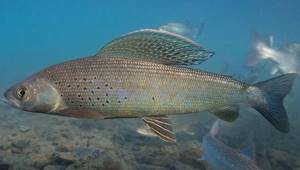
Big rivers
Grayling fishing in winter in Siberia usually occurs in greater numbers and on large rivers. Grayling is in season here. On powerful arteries, they begin to catch it on ice edges in quiet deep areas near the shore. Locals claim that the grayling is driven into such corners under the ice by sludge, rushing in tons along the current of the river, which has not yet completely frozen. This is the so-called fishing in the lower reaches.
Fishing in the upper reaches takes place on completely frozen rivers, and is similar to the process described in the previous part. Here it is important to move around and find the points where the grayling stands. On some rivers it remains in winter, on others it migrates, sliding into the mouth zone when it flows into a larger body of water. Therefore, you need to make inquiries in each specific area.

Lakes
You can catch grayling in winter on northern lakes, as well as on Baikal and man-made reservoirs in the corresponding regions. Winter fishing for grayling on Baikal and other lakes - primarily search in rocky banks with depths of 2-5 meters and in the mouth zone of tributaries. On Ladoga, grayling is found in the northern part of the lake, as well as on numerous other lakes to the north, especially in Karelia.
Distribution and habitats
The fish lives only in cool, fresh environments with moderate to strong currents, leading a sedentary lifestyle. The distance of food migrations does not exceed 10-40 km. Siberian grayling is distributed in the northeastern part of Eurasia in the basin of the Pacific and Arctic oceans. It is most numerous in rivers and their tributaries flowing into the Laptev Sea, Kara and Okhotsk Seas (Ob, Lena, Amur, Yenisei). A large representation of the taxon is typical for Lake Baikal, Altai and Mongolia.
To learn more:
Catching predatory fish with a Tyrolean stick
To a lesser extent, the species is found in the Urals, in the basins of the Baltic and White Seas, mountain or spring lakes, and vast reservoirs where people release them.
Siberian grayling feels excellent in fast currents, but always tries to choose areas with a moderately smooth flow or relative calm for long-term parking. Due to the nature of surface feeding, the fish does not need great depths, occupying the top layer of 1-2 meters. In this case, the characteristics of the bottom are important, which should be hard, not form excessive turbidity and provide a sufficient amount of reliable shelters - coarse sand, pebbles, stones, boulders, snags.
Regardless of size and age, all individuals in the flock try not to stray far from the shore, preferring to hide in the shade of bushes and trees, where there is the highest probability of insects falling to the surface of the water.
How to find grayling in winter
Under the ice, winter grayling are not as active as in summer. This is due to both the reduced metabolism of the fish and the general deterioration of lighting. Grayling relies more on vision when hunting. On small rivers there is constant movement and search. On the edges, when the possibility of movement is limited, we drill several promising places and try to seduce the handsome fish with various baits or ways of playing.
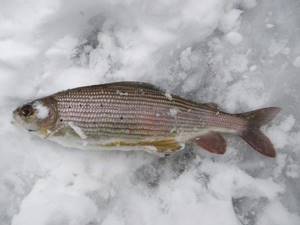
Search tactics in winter
Catching grayling from under the ice is always an adventure. And so that catching this fish is not an accident, you should adhere to certain tactics. If on a uniform large stretch, lake or section of a river, where there is absolutely nothing to attach to, we search in a checkerboard pattern, then on small rivers we use special tactics, taking into account the indicated promising places.
- The tactical meaning of the search is to find those quiet places next to the stream where this predator likes to stand. Grayling never changes this habit - neither in winter nor in summer. However, the river is under ice, and it is difficult to immediately determine the boundary between calm water and stream.
- Therefore, we drill a row across. It is necessary to evaluate the strength of the current and find the main stream. When this is done, we check everything in calm water near this stream. If the current differs significantly between some holes across the river, then we drill along this level, closer to calm water.
- We drill the entire stream, look for points with calm water - that’s where the grayling will stand. At the beginning and end of the pool, we look for places where the current weakens or begins to intensify.
- We check all local holes, turns, creeks, depressions in the riverbed, as well as the corners of flat holes along the entire river under the bank.
- We also check shallow waters adjacent to anomalies with a pebble or stone bottom.
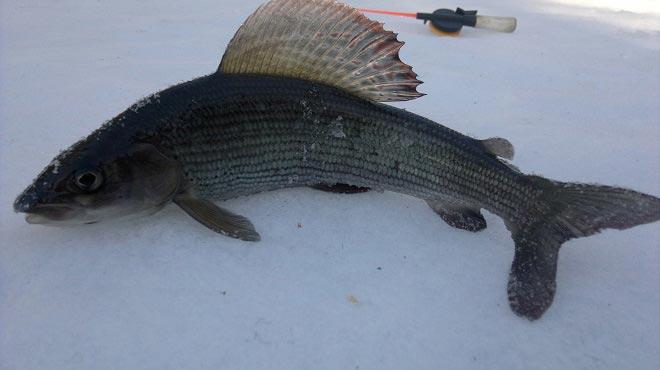
Disguise
On transparent ice during winter fishing for grayling, you need to wear camouflage. This predator is not afraid of the noise of the ice drill and does not leave its home. However, he sees everything perfectly, and will not approach the fishermen flickering on the ice, and will not try the bait.
Some fishermen cover themselves with blankets on the first ice on the shallows and catch closely. He is frightened by the sharp light passing through the thickness of the ice into the hole. Experienced grayling fishermen do not clean the holes by piercing the sludge with the handle of a slotted spoon and lowering the bait into the resulting small hole.
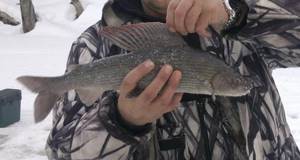
Tackle for catching grayling in winter
The usual winter tackle for grayling is a regular fishing rod with a nod and a jig. A light or front sight is placed above the main heavy jig, on a leash or with a locomotive. The second popular tackle is a weight, a sinker at the end and a retractable leash with a hook.
You can use natural baits on hooks and jigs. Some fishermen prefer to fish with bait, others with artificial flies, and others use a combination. Large grayling can also be caught with jigs and small vertical spoons, like perch.
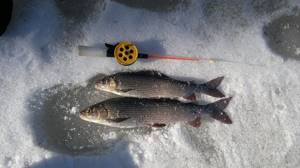
Fishing rods
Fishing with a jig or fly involves an active method of fishing with one fishing rod. The fisherman needs to choose the right working bait, game features and working height of descent. For fishing tackle for grayling in winter, you need to use a medium-caliber fishing line - 0.14, 0.16 and higher. This is a strong fish, even a small grayling fights so actively after hooking that a 0.1 or 0.12 web may not be able to withstand it.
Some anglers fish in winter with just one jig. However, it is advisable to also make a suspension with a lighter jig or a fly on a higher outlet leash. Grayling often takes the top bait, ignoring the bottom one.
In general, the gear configuration is always the same. But you can experiment in details. Below is a jig with bait - above is a fly. Or a heavy fly agaric bait at the bottom and a small hook with a nozzle at the top. This is an experimental question and is being tested in a reservoir.
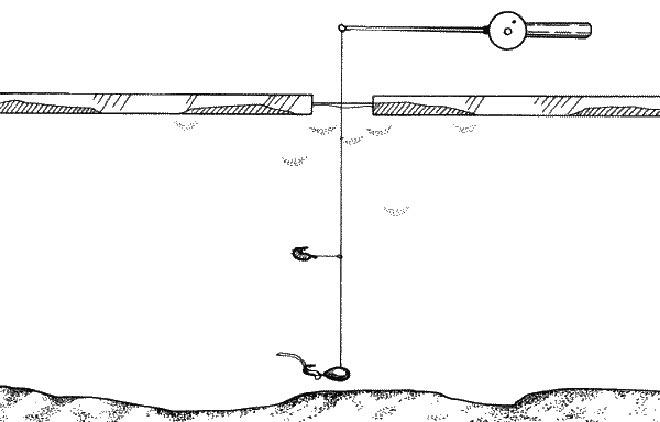
Sometimes they are caught using garlands with three or more baits. This allows you to quickly identify the working horizon, but complicates the fishing process. Grayling always hits hard on the hook. You need to pull it strongly, and at the same time gently, so as not to tear the soft lips. At the same time, additional hooks cling to the lower edge of the hole, which is why annoying slippages occur.
- The technique of the game is not very diverse; you do not need to master dozens of wires, as in the reelless game for roach. Simple twitches and pauses, tapping on the bottom, standard ups and downs. If a grayling is attracted by the bait, it will take it.
- It is useful to alternate the game with stationary hanging in the depths or at the bottom. Also, during the current, you need to try to run the equipment along the bottom with the current, driving it further under the ice according to the rolling principle. Sometimes the picky grayling in winter only takes such provocations or a quietly lying bait.
- When using natural bait, we focus more on the stationary position of the bait, natural drift and sluggish movement. We fish more actively with artificial flies or cambrics, just for the game.
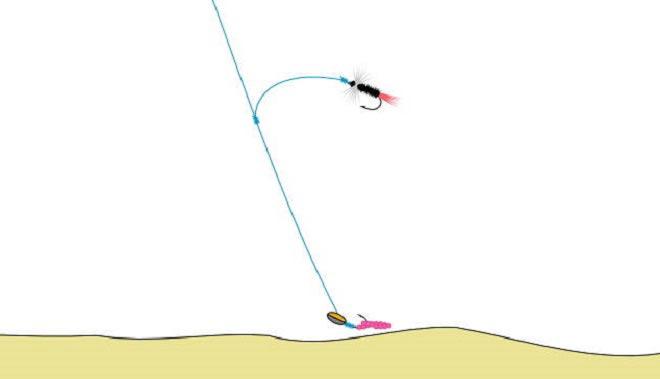
Jigs and flies
Winter flies for grayling are a kind of mixture of a jig, a fly and a sinker with a hook for bait fishing at the same time. They are usually crocheted on special hooks with a head containing a drop of lead or tin. The fly imitates a natural insect.
If in summer fly fishing uses a variety of decoys, in winter they use fly agaric baits that are less hairy and heavier. Often you need to attach bait to the fly - otherwise it won’t take it.
- On quiet reaches for small grayling, you can use the usual light jig tackle in winter, including reelless ones. However, for targeted fishing, these special baits are needed for grayling, as well as for omul, whitefish and small lenok.
- It is generally accepted that on European grayling it is better to use jigs-flies of bright colors, and on Siberian grayling - natural shades, as well as pinkish and purple, the so-called Panasonic.
- On pendants you can use light flies or cambrics - pieces of silicone on a pink-lilac hook, imitation of a tubifex worm.
Read more about the correct winter jig flies for grayling in a special article:
https://podlednik.ru/lovlya_zimoj/na-mormyshku/zimnie-mormyshki-na-hariusa
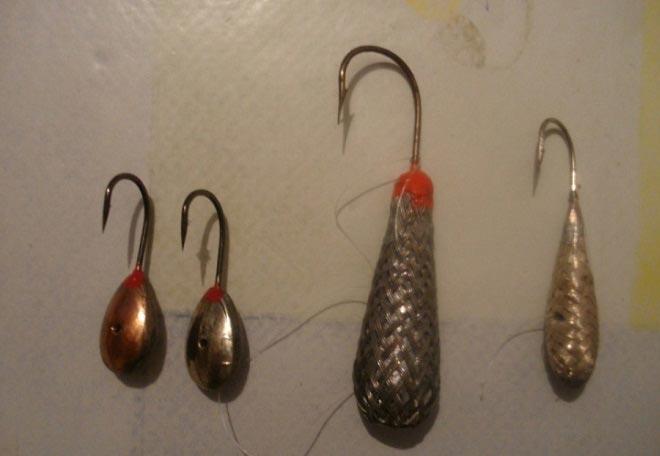
Heavy jigs for current and depth
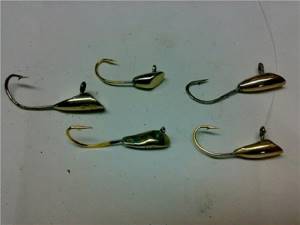
Large jigs for grayling and lenok
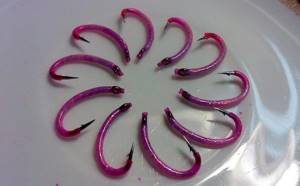
Angarsk gum (cambric)
Retractable leash and sinker (tyrolean)
What should you use to catch grayling in winter if the current does not allow you to use conventional fly-jigs? We use a regular fishing rod. At the end of such equipment for winter fishing for grayling we place a sinker of the required weight, and on the outlet leash we place the same cambric, fly or hook with an attachment.
The sinker is selected so that it stands still in this current in a calm state, and when twitching it is carried a little further, catching the next piece. This is the fishing technique.
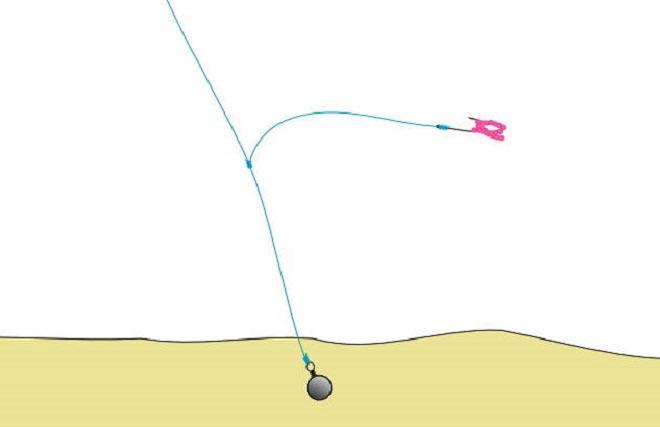
On a littered bottom or in large stones, a small load of such a winter fishing rod for grayling often gets stuck, right up to the cliffs. In such a place, it is advisable to use an ordinary Tyrolean stick instead of a sinker, or a homemade one. If instead of a sinker we put a heavy current jig weighing 3-8 grams, we get the tackle described above.
Flashing
For ice fishing for grayling, ordinary perch trolling tackle is also suitable. Usually this method works with a good bite. Winter bait for grayling for trolling - small perches 3-10 grams and 2-3 cm long. You can hang a red tail, threads or natural bait on a hook. The game of spinners for grayling is the usual twitching and pauses, we select the frequency and amplitude experimentally.
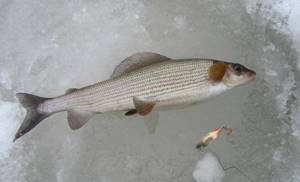
Zherlitsy
You can catch grayling in winter using a girder. Naturally, the equipment needed is not like for pike, but thinner. The same as described above for the fishing rod. Roughly speaking, this is the same fishing rod, only the signaling device is not a float or a nod, but a flag that can be seen from afar. Natural bait is placed on the hook.
It is advisable to use this method of fishing in winter when searching for passive grayling, placing several jigs in calm water along the stream, while simultaneously continuing to actively fish with a jig nearby.

Gear installation
A sliding float is installed on the main fishing line with a diameter of 0.4 - 0.5 mm, and a stopper is tied a little higher. The float is held in place thanks to a bead. For tuning, you will need a fishing line with a diameter of 0.25-0.35 mm at its end, you need to strengthen the load. Usually the tuning reaches from 0.2 to 1 m. The noose of the upper tuning loop is connected to the loop of the main fishing line.
It is recommended to pull a cambric over the eye of the weight; it prevents the line from chafing. This type of gear is simply irreplaceable when fishing for grayling. Instead of a “balda” it is quite possible to use a “pokatukha”; its difference lies in a heavier load of up to 120 grams. As a rule, such a cast is made upstream, and the load rolls along the bottom. If a strike occurs, a bite will be felt.
Selecting a “working” combination of flies is perhaps the simplest thing. If you want real fishing sensations and a good catch, it is best to go fishing on the Yenisei.
This is where you can truly lift your spirits and enjoy excellent fishing. The main thing is to choose and configure the gear correctly. Try to do it yourself, you will definitely succeed. And from the caught fish you can prepare a very tasty fish soup.
Bait and baits
Some fishermen catch grayling in winter without bait and only with artificial bait, while others use bait and lures. Both options are working, not for everybody. However, it should be taken into account that grayling in one place may actually respond better to just a fly, in another to some kind of cottage cheese or caddis, and thirdly, it can calmly take an ordinary maggot.
Let's consider what to feed grayling in winter and what natural baits can be used.
- The composition of bait for winter fishing for grayling depends on what the fish are used to eating here. If there is a mormysh in the reservoir, we feed this crustacean, if it is not there, we feed it with caddisfly or maggot. However, usually there are not so many larvae for bait - it’s already difficult to collect them for bait.
- In the shallows, the simplest old-fashioned way to attract grayling in winter is to stir up the water with a stick on the bottom in the hole above the traps, and repeat this periodically. Grayling always comes to the mud to check if there is anything tasty.
- In some reservoirs, grayling go to cottage cheese in winter. And small pieces of white foam are placed on the hook. However, the cottage cheese must be real, made from milk, and not from palm oil from a department store.
- The simplest do-it-yourself bait for grayling in winter is fine breadcrumbs with dry milk (natural). To this mixture, be sure to add small maggots, jigs - anything living and protein that we catch on a hook. The crackers themselves do not attract the predatory grayling with their taste - but they create the necessary cloud of turbidity.
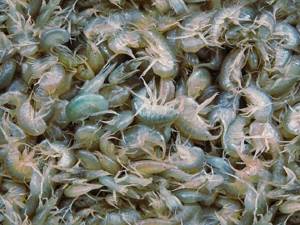
Baits for grayling in winter
The best bait for winter grayling is caddis larva, the natural and favorite food of this fish. It is obtained in winter using a special scoop net, collecting houses from the bottom along with soil along frozen streams.
You can install bu birch brooms in the holes, pinching potato peelings among the twigs. In 7-10 days, such a broom can be favored by dozens of larvae. Catching caddisfly is labor-intensive, but grayling will never miss such a delicacy.
Not every angler likes to bother with finding caddis flies, so instead of it, ordinary maggots, worms, bark beetle or Chernobyl larvae are used - any standard worm bugs for fishing. Large grayling from the ice can also take small 2-3 centimeter fry, attached to a hook like a worm. However, where can you find something like this in winter?
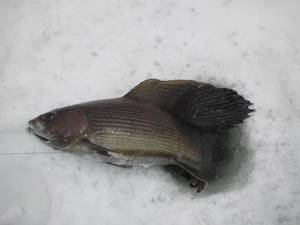
Overseas float
An Italian development called sbirulino has become a traditional tackle for catching the “red legend”. It is a weighted float for long casts, resembling an elongated egg or a small projectile. The immersed end is less elongated and contains a small load inside.
The bulldozer is made only from light materials, otherwise it will turn out to be a donka.
Siberian fishermen made the base from wood or willow bark (it floats well), and the Italians preferred to use cork to make sbirulino. Nowadays, specimens made of special compacted foam are becoming increasingly common.
The “fishing weight” – lead – is used as cargo. One end of the beam is drilled, a small roll of this metal is placed there, fixing it with glue.
The tie acts as the axis of the tackle and at the same time serves as a fastening for the fishing lines. Before installing it, the bombard is drilled through, from end to end.
The protruding parts of the wire are bent, making loops of two or three turns.
Only durable stainless metal is suitable as a connector. As a result of corrosion, the tie can come apart, which often leads to the loss of bait, or, even worse, fish.
The European version of sbirulino has a slightly different appearance, resembling an ordinary float with a stabilizer. As for installation, the only difference is the absence of a wire tie inside the body.
Here the main line is not tied anywhere, but is driven through, that is, through the bulldozer. To prevent the float from “moving” along the entire line, anglers use silicone stop beads that can be moved to adjust the depth.
Often such floats are made with stabilizing wings, like a rocket, to increase the throwing range.
Fishing for grayling with a float rod is not as widespread as spinning fishing for grayling. This option is ideal on small rivers, where the depth of the reservoir does not allow you to roam with other gear. Grayling is caught with a float rod in the same way as any other fish. A fishing rod for grayling can be of any length, from ultra-light 3-meter rods to full-fledged fishing rods 6-6.5 meters long.
On light models you don’t even need to have a reel; you just need to attach the reel to the rod. For long fishing rods, it is preferable to equip them with a light reel with a spool size of 1000-1500.
In order to properly assemble the tackle, you need the following:
- light balsa float
- sinker
- hooks
The float must be loaded so that even the slightest bite is visible on it. Hooks can be assembled on the rig in tandem, at a distance of 20-30 cm from each other. In this case, you can attach a different attachment, or use a fly instead of a second hook.
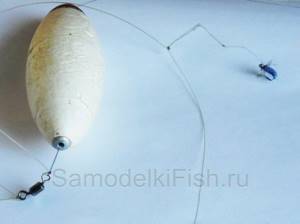
Maggots, bloodworms, bark beetles or pieces of fish are used as bait material for float fishing. You can bait it with cottage cheese; grayling gathers well on the dregs it creates.
Nuances of fishing techniques
Let's take a closer look at how to catch grayling in winter from the point of view of technique and the nuances of direct work on the ice with holes and gear. This fish usually bites confidently, and there are no problems with hooking. You need to fish quickly, but smoothly, without sudden jerks, giving away part of the fishing line and returning it back if the fish is large.
- It happens that grayling takes sluggishly. If there are empty bites in the dead of winter, you need to reduce the fly or the size of the nozzle, and also wait a little until it swallows.
- Initially, we check the usual equipment in a version that once worked normally. If it doesn’t take in an obviously good place, we try other options, change the fishing horizon, bait and methods of play.
- When fishing while standing, you sometimes need to twitch the bait. You shouldn’t set out 10 fishing rods and wait for a bite, like when fishing for crucian carp. It’s better to work more actively with 2-3 fishing rods, or even just one – drill more, change places more often, twitch or actively lower under the ice using the rolling principle.
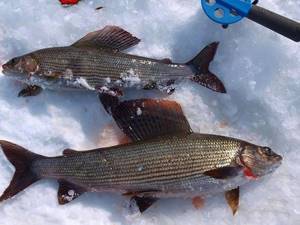
Weather influence and seasonality
In what winter weather does grayling bite best? It all depends on the general illumination, terrain and seasonality of winter. In some reservoirs, grayling catch better in the morning and a little worse in the evening - anglers in such places move to points while it is still dark. This is especially common in clear frosty weather.
During thaws, especially long ones, this predator begins to actively move and can be caught well all daylight hours.
All this again depends on the area. In principle, grayling is not very dependent on weather conditions; the weather for grayling fishing plays a secondary role. It can be caught both in forty-degree frost and on warm cloudy days. The approach is the same as for any other fishing. Smooth weather is always better, as when it changes the bite can become unpredictable. The peculiarities of its bite need to be clarified for each area individually - they can differ significantly.
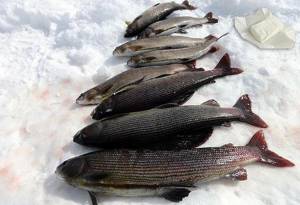
Early winter
During the first ice on small rivers in December, grayling may not approach the bait simply because they see an angler if there is no snow. Therefore, on a clear day, you need to fish on first ice in the morning, and in the afternoon - in areas with shade from the shore. The sludge from the hole is not cleared out. Some anglers even lie down on the ice and cover themselves with a blanket, creating a shady area.
- On large rivers, fishing for grayling in December is possible if the ice has cleared up by this time, or at least edges have formed. Just at this time, when sludge flows along the main channel, grayling presses closer to the banks, where it is cleaner and quieter.
- On small rivers, fishing for grayling in November is problematic simply due to their availability. There is no ice yet on the fast-flowing streams, and it is impossible to reach the cherished points along the riverbed. However, where you can approach from the shore, on the described secret reaches, whirlpools and beaver nests, you can count on a good active bite.
More information about fishing for grayling on first ice: link coming soon
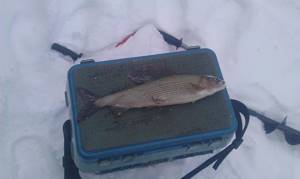
Glukhozimye
In January, fishing for grayling on small rivers means searching and searching again. The fish are already in their favorite wintering areas. And these points need to be precisely found, since grayling rarely wanders in the dead of winter. In February, the bite usually gets worse - you need to search even more, use smaller baits and neat rigs. The situation is the same on large bodies of water. The fish stands, but continues to feed. With the right skill, catches can be quite significant.
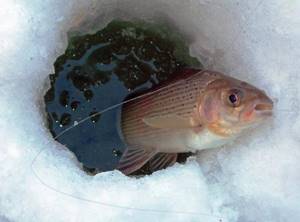
End of winter
Closer to spring, the usual operating points may cease to please with bites - grayling in March begins to rise to the upper reaches, where the water is cleaner and better enriched with oxygen. In addition, with the breaking of ice and high water, the middle and lower currents will be too stormy, filled with ice floes, slush and dirty water. From large rivers, grayling usually also rises into small flowing rivers - that’s where you need to look for it.
